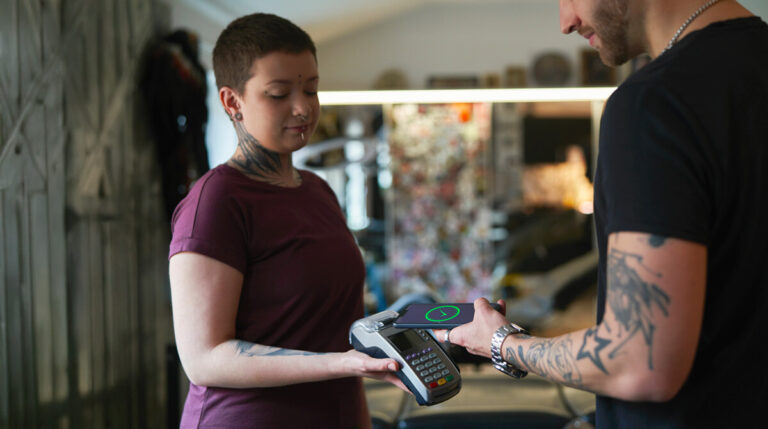A card-present transaction involves a physical card – it is swiped on a point of sale system and often involves providing additional verification like a PIN or a signature.
But more and more people want to pay for products and services without presenting a physical card or digital wallet.
They’re opting for what is known as card-not-present transactions.
In this article, you’ll learn about the different types of card-not-present transactions, and how to process them as safely as possible.
What is a Card-Not-Present Transaction?
A card-not-present (CNP) transaction is a transaction where the card used is not physically present during the transaction, such as online purchases, phone orders, and mail orders. CNP transactions are typically processed using a POS system, virtual payment terminal, hosted payment page, and/or online payment gateway.
With a CNP transaction, the card information is manually entered into a payment system either by the customer or by the merchant.
Types of Card-Not-Present Transactions
Here are the most common types of CNP payments:
- Phone orders. A customer contacts you by phone to place an order. They provide their card details and you manually enter them into your payment system.
- Text-to-pay. You send an invoice to a customer, the customer receives a payment link on their phone, and they can choose their preferred payment method.
- Online ecommerce purchases. You might know this as the typical online shopping cart experience on websites like Amazon.
- Website payments. This is a payment page on a website that lets you enter your card details and initiate payments.
- Recurring payments. Payments for subscriptions are typically authorized once, and then get charged automatically without needing a physical card to be present every time.
A Note on Mobile Wallet Payments
More and more people are paying with mobile wallets on their phones – such as Apple Pay.
This contactless payment method only requires a phone with a mobile wallet to be in close proximity to the credit card terminal in order to pay. The cardholder is physically present, but the card isn’t necessarily. Because it contains the same data as a card – but often much more secure (think TouchID, FaceID etc.) – it’s deemed secure enough to be considered a card-present transaction.
Are Card-Not-Present Transactions Safe?
Card-not-present transactions pose a higher risk of fraud compared to card-present transactions. This is because criminals can use compromised credit card information and pretend they are the legitimate owner of someone else’s credit card.
According to data from Insider Intelligence, card-not-present fraud makes up 73% of card payment fraud – and both the amount and the percentage are increasing.
While these statistics should be taken seriously, there are several best practices to minimize CNP fraud.
- Make sure to not only ask for the credit card details, but also request all of the customer contact information including phone number, email address, shipping address, and billing address.
- Always use the card verification value (CVV) as an extra authentication method for CNP transactions. The CVV is the three-digit security number that is usually on the back of the card.
- Use the Address Verification Service (AVS) to verify the address provided by the customer along with the credit card details. This service double checks the address against the address in the records of the credit card issuer. If you work with Gravity Payments, we can help you become PCI compliant and set up your payment system so that it meets the highest security standards.
- If possible, use multi-factor authentication. Send a code to the verified phone number of the customer if they have previously provided their phone number.
- If you still have doubts, don’t proceed with the transaction immediately. Contact the credit card company, voice your concerns, and explore ways to confirm that you have been talking to the actual owner of the credit card.
By using the above security measures, you minimize your exposure to fraud. We understand that following these processes can seem a bit complicated. But after doing it a few times, it will become second nature! We are happy to help you get the hang of it.
How Much Do These Transactions Cost?
Credit card interchange fees are almost always higher for CNP transactions because card-not-present transactions are considered riskier than card-present transactions – that’s due to the higher risk of credit card fraud.
Your CNP transaction fees vary based on your situation.
Gravity Payments uses a transparent credit card pricing structure for its payment processing services. Don’t hesitate to contact us if you have any questions regarding the fees for card-not-present transactions in the context of your business.
TIP: If you are taking the physical card from a customer and keying in the details manually into your credit card terminal instead of swiping it, this is still considered a card-not-present transaction. This means you may be paying too much in processing fees!
What Businesses Benefit from Accepting Card-Not-Present Transactions?
CNP transactions are useful for various types of businesses. Let’s take a look at some examples.
Online Businesses
Businesses that operate online – and don’t have a physical location – process CNP transactions exclusively. Most modern ecommerce platforms such as Shopify and Amazon use their own online payment systems. But let’s say you own a veterinary clinic and want to accept payments online on your website – you can still do that by using a payment page that connects to your payment processor.
Invoice-Heavy Businesses
Let’s say you send your invoices via email, physical mail, or text message – or a combination. Your customers typically have several payment methods to choose from, and as a result, most of the payments you receive are made without the physical card present.
Businesses with a lot of Phone Orders
If you receive a lot of orders over the phone, it’s useful to be able to retrieve the customer’s payment details and manually key them into your payment system. Examples of this are restaurants that accept takeaway orders by phone, and retail stores that offer curbside pickup.
Accept Card-Not-Present Payments with Gravity Payments
Accepting card-not-present payments provides convenience for your customers, and for some businesses, accepting this type of payment is essential.
With Gravity Payments’ merchant services, you can accept both card-not-present and card-present payments and offer a variety of payment methods to your customers. We provide a white-glove setup and training, and can advise you on the best payment processing setup for your business.
Not sure whether you should accept card-not-present payments, or still have more questions? The team at Gravity Payments can help – contact us here.




